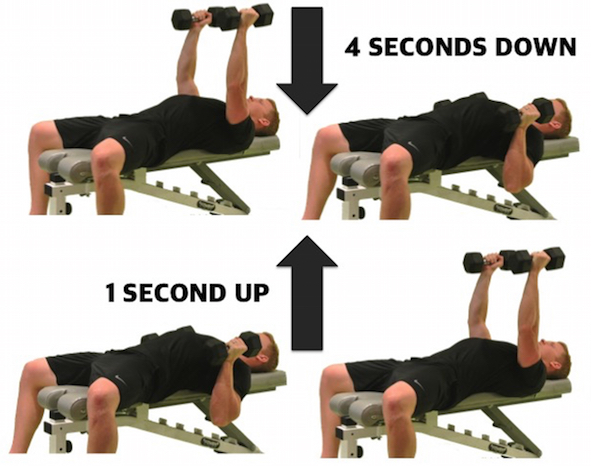Tempo is the speed of a movement, or the time you dedicate to each individual rep. Usually it’s presented in a 4-digit sequence, with the first number applying to the eccentric part of the exercise (muscle lengthening), and the third number representing the concentric portion (muscle shortening).
Tempo = 4 – 0 – 1 – 0
- Eccentric = 4 seconds
- Concentric = 1 second
If you applied this 4-0-1-0 tempo to the bench press, it would equate to 4 seconds of lowering the bar to your chest, and 1 second to press it. The 0’s in between are reserved for pauses – at the chest, or with the arms extended – and in this case there aren’t any.

Unfortunately, tempos are often scoffed at in the fitness community; despite carrying a significant amount of scientific support. For instance, the first number in the tempo (the eccentric action) is more critical to gaining muscle (1, 2, 3) and leads to far greater development than the concentric action (third number). So it makes sense to spend more time there.
- A research study from 2006 in the journal Medicine and Science in Sports and Exercise, split participants into 2 groups with one doing only the eccentric part of an elbow flexion exercise and the other doing only the concentric portion. Not only was muscle development significantly higher in the eccentric group (11% vs. 3%), but they had equal improvements in concentric strength (14% vs 18%), and far greater improvements in eccentric strength (26% vs 9%).
- In another study in the year 2000, researchers in the Journal Physiology tested quadricep development and found far greater increases in strength and hypertrophy for those performing the eccentric-only training, compared to those doing concentric-only.
The reasoning for this, is that the eccentric action in an exercise appears to be less metabolically demanding (less motor unit activation required) while supplying greater force production per unit of muscle size. Meaning, heavier weight can be applied with less muscular stress.
“…the superiority of eccentric training to increase muscle strength and mass appears to be related to the higher loads developed during eccentric contractions.” British Journal of Sports Medicine, 2009
This is something most of us can relate to, as it always seems significantly easier to resist a heavy weight, than it is to push or lift one. With lying on your back and pushing someone off of you versus preventing them from getting too close, being the perfect example.

Aside from the superior force-to-stress relationship, we also see greater elevations in muscle protein synthesis, superior hormonal increases (IGF-1, gH), and greater muscle tension, damage, and recruitment (1, 2, 3) by spending more time in the eccentric portion of an exercise. Thus, if we’re looking to extend the Time Under Tension and experience hypertrophic adaptations (build muscle) without sacrificing strength, it seems to make sense to “lower slower.”

Fortunately for us, research also suggests that performing the concentric action with a quicker speed (explosively) is optimal for developing strength (1, 2, 3, 4). Meaning, a slow eccentric and fast concentric tempo of 4010 or 3010 put us in the optimal zone for growth.
- 4-0-1-0 x 8-10 reps = 40-50sec TUT
- 3-0-1-0 x 10-12 reps = 40-48sec TUT
Realistically, the 1 could be swapped for an ‘X,’ as we usually want to execute our push or pull with explosiveness, or the intent to maximally accelerate it. Not only because this is ideal for strength development, but because it helps build and maintain the explosive Type II muscle fibers that drastically reduce with age (1, 2, 3).
“Humans can lose up to 40% of their muscle mass by the age of 80, with preferential reduction in the cross-sectional area (CSA) of the fast, powerful fibers that contain type 2 myosin.”
Performing the concentric part of each exercise with a powerful push or pull counteracts the reduction in type II fibers that impairs mobility and increases the risk of falls and fractures with age. Which may sound like a ridiculous rationale, but these falls are commonly what sends the elderly population on a path to early death.

Interestingly, this practice can be so effective at recruiting fast-fibers that research continuously shows better type II development with lighter weights, when compared to normal speed contraction and heavier loads. For instance:
A study from 2005 in the Journal of Gerontology determined that the greatest improvements in muscle power for older adults was found using 50% of 1RM and training with an explosive push or pull.
Meaning, it’s less about what you lift, and more about how you lift; since the maximal contraction outweighs the load. And suggesting that no matter your age, or current ability, you can develop power (and muscle) without selecting max weights and sacrificing your form (1, 2, 3, 4, 5).
But more importantly, when you combine these fast concentrics with the slow eccentrics mentioned earlier, you get everything we’re looking for from weight training:
- A controlled TUT to benefit from the elevated metabolic stress and protein synthesis that promotes hypertrophy
- More time spent in the eccentric action for greater strength and muscle developments
- The ability to perform the concentric action with speed to stimulate type-II muscle fiber action
- No sacrifice in mechanical tension (strength) in an effort to increase metabolic stress (muscle)
In addition to superior execution and a lower risk of injury. Which are critical, and often neglected, components…even for the experienced.
Stay Lean!
Coach Mike
RELATED ARTICLES:
Is There An Optimal Rep Range?
How Urgent is Post-Workout Protein?
1% Fitness FAQs - Looking to Gain Mass
